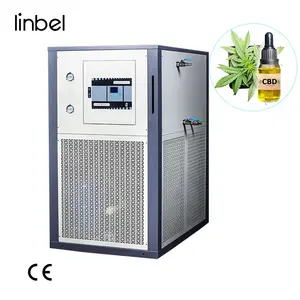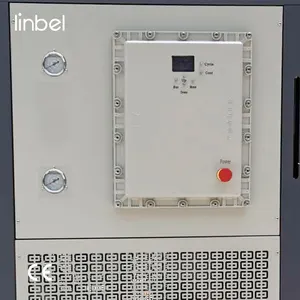(2697 products available)




















































































































































































































An industrial chiller is a type of machine used to remove heat from various liquids. Such as water and coolant, which are then used to dehumidify air and equipment. In a manufacturing plant, a chiller is used as part of the HVAC system. The Hitachi chiller comes in different types, each suitable for various applications and industries.
This Hitachi chiller uses heat as an energy source to drive the refrigeration cycle. These types of chillers are commonly used in large industrial or commercial facilities where waste-heat recovery or steam power is available.
The Hitachi screw chiller uses a screw compressor to pump refrigerant through the system. This type of chiller is commonly used in medium to large-scale commercial and industrial applications due to its energy efficiency and capacity. There are two types of screw compressors used in screw chillers: the twin-screw compressor and the single screw compressor. The twin-screw compressor is more common and has two interlocking screws that rotate to compress the refrigerant. The single screw compressor has one main screw and two gate rotors. Screw chillers are available in air-cooled and water-cooled systems.
This chiller uses ambient air as the coolant through the use of one or more condenser fans. Air-cooled chillers are typically used for small to medium-sized commercial and industrial applications. This includes office buildings, data centers, and manufacturing plants. The advantages of air-cooled chiller are that they do not require a cooling tower, which saves space and simplifies installation. They are also more efficient in cooler climates when the temperature difference between the ambient air and the refrigerant is higher. One of the downsides of air-cooled chiller is that they consume more energy than water-cooled chillers.
This cooler uses water to absorb heat from the refrigeration chiller. Water-cooled chillers are typically used for medium to large-sized commercial and industrial applications. This includes office buildings, hospitals, and schools. The advantages of water-cooled chiller are that they are more energy efficient and provide more capacity than air-cooled chillers. They are also quieter and have less maintenance. One of the downsides of water-cooled chillers is that they require a cooling tower to reject the heat absorbed by the refrigerant during the cooling process.
Hitachi chiller specifications can be distinguished based on the type of chiller they have, and they are as follows:
Hitachi's air-cooled chiller comes in an ACUMii™ chiller control system and an inverted driven rotary screw compressor, which allows the chiller to function quietly and efficiently. Its cooling capacity ranges from 15 to 550 tons, and it can operate in a temperature range of 25°F to 115°F.
Hitachi's water-cooled chiller has an ACUMii™ chiller control system, an inverted driven rotary screw compressor, and an evaporator that is made of copper and nickel. The chiller is also able to function quietly and efficiently. Its cooling capacity ranges from 16 to 557 tons, and it can operate in a temperature range from 10°F to 125°F.
Regular maintenance of a Hitachi water chiller is necessary to ensure that it is operating at an optimal level of efficiency. Following a proper maintenance schedule can also help the chiller to have a longer lifespan and prevent unexpected breakdowns. The main components of the chiller that require maintenance are the evaporator, condenser, compressor, controls, and safety devices. The refrigerant, which is a heat transfer substance, will need to be checked regularly and replaced when necessary.
It is important to clean the evaporator and condenser regularly. The chiller will not be able to transfer heat efficiently if these surfaces are dirty. The compressor should also be inspected to ensure that it is operating properly. It is important to lubricate the compressor and check the oil level. The controls and safety devices need to be tested regularly to ensure that the chiller is functioning within the safe operating parameters. The water-cooled chiller must be cleaned and water treated to prevent algae growth and scale buildup inside the tubes. The chiller's heat transfer efficiency will be affected if this happens. The water-cooled chillers and the air-cooled Hitachi chiller fans should be checked to ensure that they are working properly.
Hitachi chillers are used in a variety of applications in commercial and industrial settings, providing cooling solutions for different industries and facilities.
Hitachi chillers can be used in office buildings, shopping centers, hotels, and other commercial buildings. Hitachi chillers provide a comfortable indoor environment by providing cooling for the entire building.
In data centers, Hitachi chillers play a crucial role in maintaining the optimal operating temperature for servers and other IT equipment, ensuring stable and reliable data processing and storage.
Hitachi chillers can be used in hospitals, clinics, and other healthcare facilities to provide precise temperature control for operating rooms, laboratories, imaging facilities, and other areas. Hitachi chillers ensure a safe and comfortable environment for medical staff and patients.
In manufacturing plants and factories, Hitachi chillers are widely used in the chemical, automotive, food processing, and other industries. They cool production equipment, control rooms, and other areas, ensuring the quality and efficiency of manufacturing processes.
Hitachi chillers are often used in server rooms to ensure the reliable operation of IT infrastructure. Hitachi chillers help dissipate heat generated by servers and other equipment, maintaining a suitable temperature and humidity levels to prevent equipment damage.
In the pharmaceutical industry, Hitachi chillers are commonly used for research and development laboratories, production facilities, and storage areas. Hitachi chillers maintain strict temperature control to preserve the integrity of drugs and ensure compliance with regulatory requirements.
Hitachi chillers can be used in hotels, resorts, and other hospitality venues to provide guests with a comfortable indoor environment. Hitachi chillers are used in rooms, conference centers, and other facilities.
In supermarkets, Hitachi chillers are used to cool and freeze the fresh food section, provide frozen storage for perishable foods, and maintain the ideal temperature for food preservation. Hitachi chillers can also be used in refrigeration systems for food and beverage storage and display.
When it comes to choosing a Hitachi chiller, it is important to keep in mind that the right choice depends on the specific needs, preferences, and priorities of the business or organization. Below are some factors that can influence the decision:
It is important to determine the cooling capacity required by the specific application. Also, consider the appropriate size of the chiller to ensure that it can be properly accommodated in the facility.
Consider the energy efficiency rating of the chiller, as well as features such as variable speed compressors and advanced control systems. Such features can help to maximize energy efficiency and reduce operating costs.
Consider the availability of local service providers for Hitachi chillers and assess the maintenance requirements of different models. This will help ensure that routine maintenance is easy to perform in the long term.
Consider the upfront cost of the chiller, as well as long-term operating costs. While it is important to choose an option that meets the budget, it is also vital to consider the overall value and efficiency that the chiller can provide over time.
Ensure that the chosen Hitachi chiller is compatible with existing HVAC systems or other equipment at the facility. Also, consider how well the control interface of the chiller can be integrated into the facility's overall system.
Q1 What is the expected lifespan of a Hitachi chiller?
A1 The lifespan of a chiller depends on factors such as usage, maintenance, quality, etc. Properly maintained Hitachi chillers can last 20 years or more.
Q2 What are the benefits of regular chiller maintenance?
A2 Regular maintenance ensures efficient performance, prolongs chiller lifespan, prevents costly repairs, maintains indoor air quality, sustains energy efficiency, and ensures safe operation.
Q3 Is it possible to retrofit an existing chiller system with Hitachi chiller components?
A3 It is possible to retrofit some existing systems with Hitachi components, but it depends on factors like the current system setup, compatibility, and the assistance of qualified technicians.
Q4 What are some common signs that a chiller requires immediate attention?
A4 Unusual noises, fluctuating temperatures, increased energy consumption, leaks, and frequent error messages are some signs of chiller malfunction. Contact a technician immediately if these signs appear.
Q5 Can the efficiency of an older chiller be improved without replacing the entire unit?
A5 Yes, some ways to improve an older chiller's efficiency include regular maintenance, optimizing controls, cleaning tubes regularly, upgrading components, and optimizing the chiller's operation.